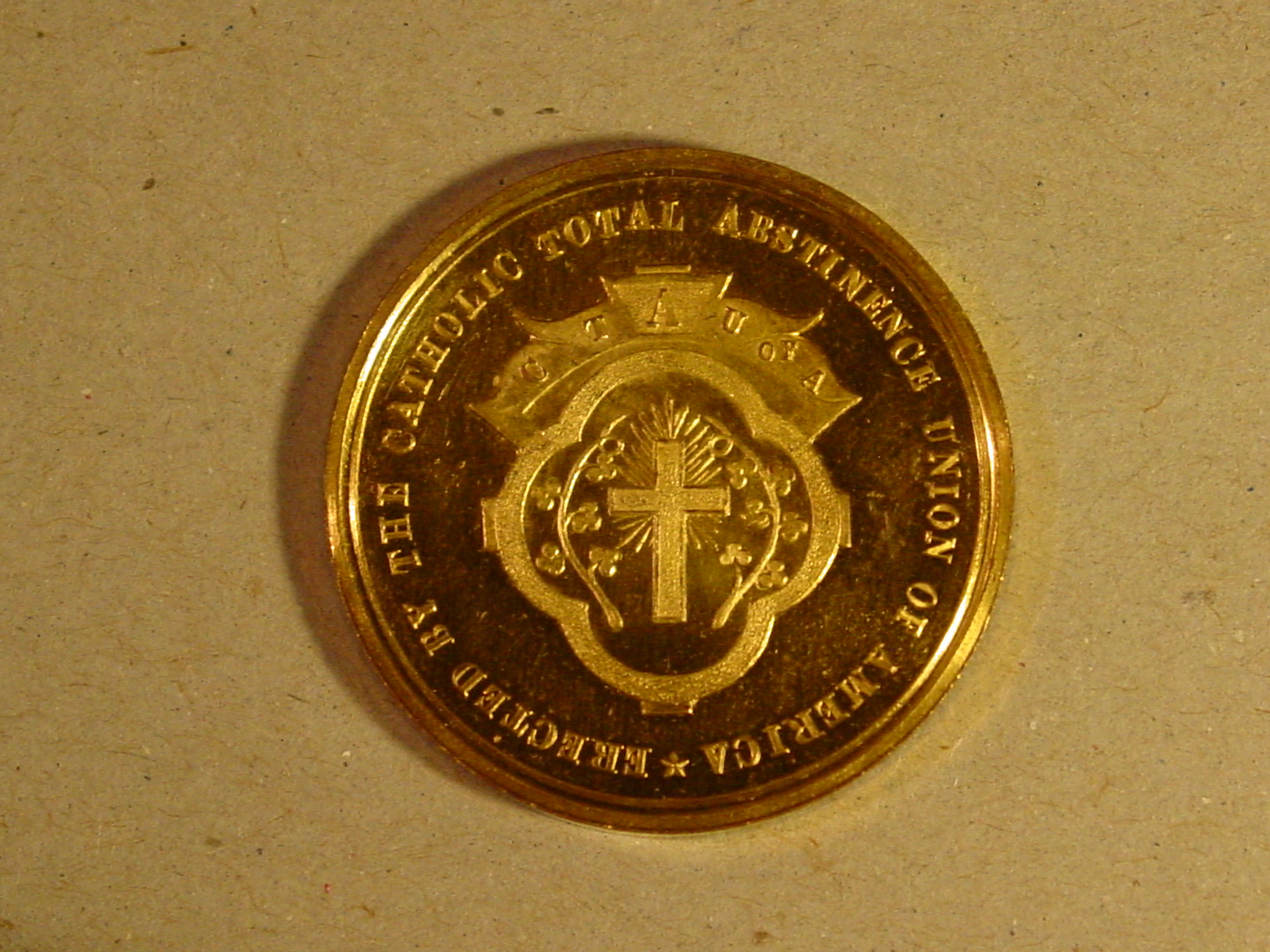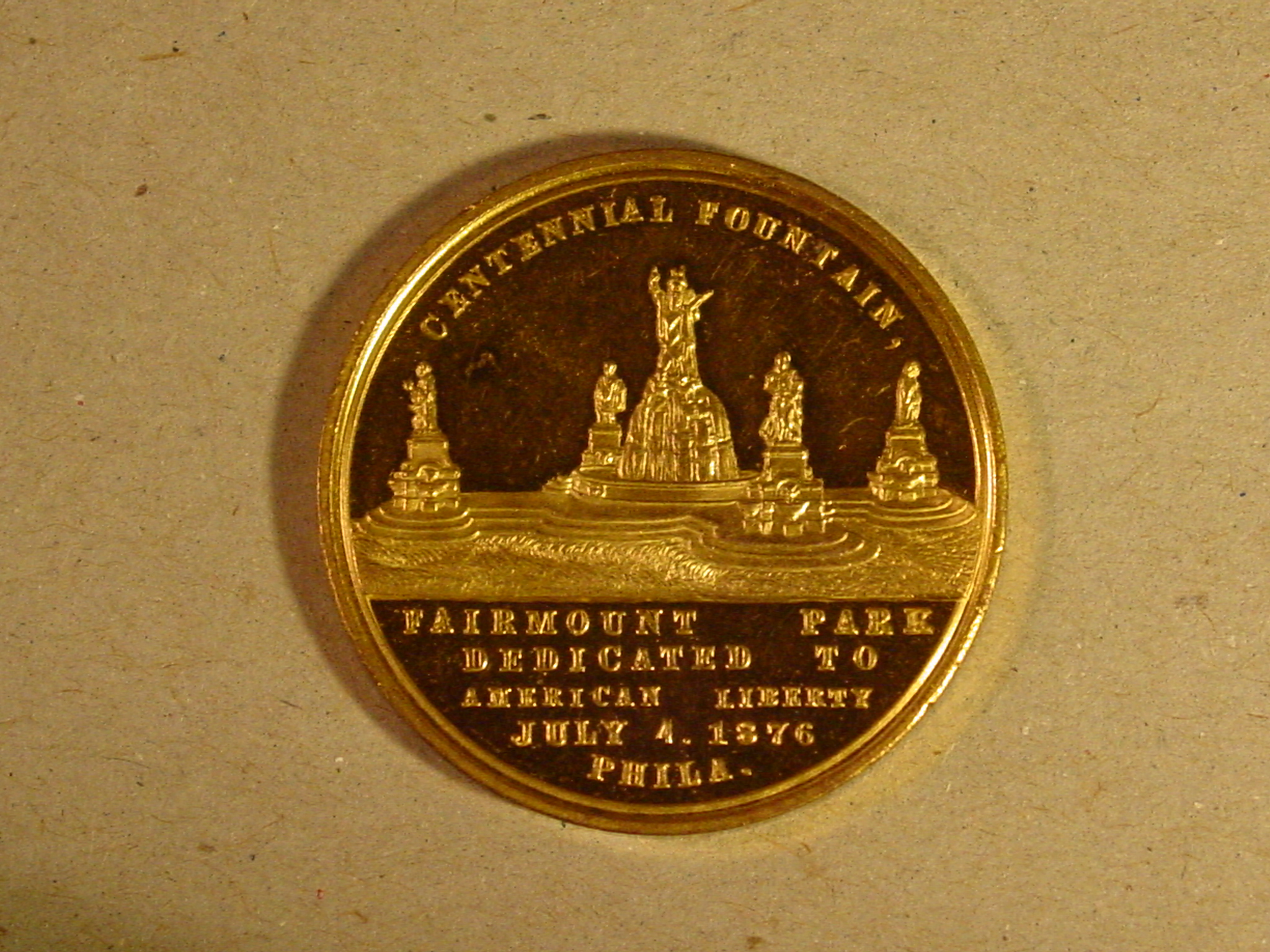So-Called Dollar Discussions
HK-69 Centennial Fountain
Quote from Pioneer on August 11, 2011, 11:02 pmI am not an expert on the 1876 US Centennial Exposition, but one SCD piece that caught my eye several years ago was HK-69 -- due to the religious reference on the reverse. The obverse shows the centennial fountain now commonly referred to the "Moses Fountain" that remains to this day in Fairmount Park, Philadelphia, PA. This large fountain (aka. Centennial Fountain) has five marble statues -- Moses (in the middle) with four surrounding important Irish-Catholic Americans -- Charles Carroll (last surviving signer of the Declaration of Independence [NCM Turner-42]), his cousin Archbishop John Carroll (a staunch defender of religious liberties), Commodore John Barry (Revolutionary war Naval hero), and finally Father Theobald Matthew (founder of the temperance movement in Ireland). The symbolic purposes of using Moses was to mirror a story from the biblical book of Exodus -- Moses striking a rock and water flowing from it for the people of Israel, with them drinking the water and becoming enlightened to the miracles of God. Note that a key element of the fountain was to serve as a public source of clean drinking water, something the Fairmount park engineers planned for this fountain to provide. The concept and fundraising for this grand centennial fountain was by the Catholic Total Abstinence Union (CTAU) of the Diocese of Philadelphia, an organization whose goal was to champion patriotism as well as the cause of Irish-Catholic temperance -- temperance being the "control of the desire for pleasure." In other words, "balancing legitimate need for goods against the inordinate desire for them." It seems that the Irish people in America were discriminated against as a minority, with alcoholism and immoral behavior made stereotypes against them. A key goal of the CTAU was to provide a support organization to combat these stereotypes through temperance. The fountain's sculptor was Herman Kirn -- a German sculptor with little known about him. He consulted with Carl Johann Steinhauser (1813-1879), an art professor in Karlsruhe, Germany and owner of a marble quarry in Laas ,Germany. Kirn struggled to finish the statues for the exposition opening, with only the Commodore Barry being installed by the official opening. The entire fountain was not completed until 4 July 1877. I think the history behind this piece is interesting as this fountain is a visible reminder of our American cultural heritage, the past social movement of temperance, and surviving example of public art. It also certainly makes me think of other SCD pieces celebrating various cultures (eg. HK-596/7 - German American Bicentennial). I am lucky enough to own the attached HK-69B (which I overpaid for but so be it). I am aware that Jeff Shevlin is selling several of these medals in the Aug 2011 Ostheimer Sealed Bid Auction in Chicago, so take a look if you're interested. edited by rjesinger on 8/11/2011
I am not an expert on the 1876 US Centennial Exposition, but one SCD piece that caught my eye several years ago was HK-69 -- due to the religious reference on the reverse. The obverse shows the centennial fountain now commonly referred to the "Moses Fountain" that remains to this day in Fairmount Park, Philadelphia, PA. This large fountain (aka. Centennial Fountain) has five marble statues -- Moses (in the middle) with four surrounding important Irish-Catholic Americans -- Charles Carroll (last surviving signer of the Declaration of Independence [NCM Turner-42]), his cousin Archbishop John Carroll (a staunch defender of religious liberties), Commodore John Barry (Revolutionary war Naval hero), and finally Father Theobald Matthew (founder of the temperance movement in Ireland). The symbolic purposes of using Moses was to mirror a story from the biblical book of Exodus -- Moses striking a rock and water flowing from it for the people of Israel, with them drinking the water and becoming enlightened to the miracles of God. Note that a key element of the fountain was to serve as a public source of clean drinking water, something the Fairmount park engineers planned for this fountain to provide. The concept and fundraising for this grand centennial fountain was by the Catholic Total Abstinence Union (CTAU) of the Diocese of Philadelphia, an organization whose goal was to champion patriotism as well as the cause of Irish-Catholic temperance -- temperance being the "control of the desire for pleasure." In other words, "balancing legitimate need for goods against the inordinate desire for them." It seems that the Irish people in America were discriminated against as a minority, with alcoholism and immoral behavior made stereotypes against them. A key goal of the CTAU was to provide a support organization to combat these stereotypes through temperance. The fountain's sculptor was Herman Kirn -- a German sculptor with little known about him. He consulted with Carl Johann Steinhauser (1813-1879), an art professor in Karlsruhe, Germany and owner of a marble quarry in Laas ,Germany. Kirn struggled to finish the statues for the exposition opening, with only the Commodore Barry being installed by the official opening. The entire fountain was not completed until 4 July 1877. I think the history behind this piece is interesting as this fountain is a visible reminder of our American cultural heritage, the past social movement of temperance, and surviving example of public art. It also certainly makes me think of other SCD pieces celebrating various cultures (eg. HK-596/7 - German American Bicentennial). I am lucky enough to own the attached HK-69B (which I overpaid for but so be it). I am aware that Jeff Shevlin is selling several of these medals in the Aug 2011 Ostheimer Sealed Bid Auction in Chicago, so take a look if you're interested. edited by rjesinger on 8/11/2011
Quote from bill on August 15, 2011, 1:50 pmI don't own one of these, but I agree. They are interesting and beautiful medals.
I am not an expert on the 1876 US Centennial Exposition, but one SCD piece that caught my eye several years ago was HK-69 -- due to the religious reference on the reverse. ... I think the history behind this piece is interesting as this fountain is a visible reminder of our American cultural heritage, the past social movement of temperance, and surviving example of public art. It also certainly makes me think of other SCD pieces celebrating various cultures (eg. HK-596/7 - German American Bicentennial). I am lucky enough to own the attached HK-69B (which I overpaid for but so be it). I am aware that Jeff Shevlin is selling several of these medals in the Aug 2011 Ostheimer Sealed Bid Auction in Chicago, so take a look if you're interested. edited by rjesinger on 8/11/2011
I don't own one of these, but I agree. They are interesting and beautiful medals.
I am not an expert on the 1876 US Centennial Exposition, but one SCD piece that caught my eye several years ago was HK-69 -- due to the religious reference on the reverse. ... I think the history behind this piece is interesting as this fountain is a visible reminder of our American cultural heritage, the past social movement of temperance, and surviving example of public art. It also certainly makes me think of other SCD pieces celebrating various cultures (eg. HK-596/7 - German American Bicentennial). I am lucky enough to own the attached HK-69B (which I overpaid for but so be it). I am aware that Jeff Shevlin is selling several of these medals in the Aug 2011 Ostheimer Sealed Bid Auction in Chicago, so take a look if you're interested. edited by rjesinger on 8/11/2011
Quote from Bill Walter on February 8, 2014, 12:50 pmIts great to learn additional information about a piece. Every time that I see one of these now I will think about its history. I want to add the photos of my piece in gilt.

Its great to learn additional information about a piece. Every time that I see one of these now I will think about its history. I want to add the photos of my piece in gilt. 
